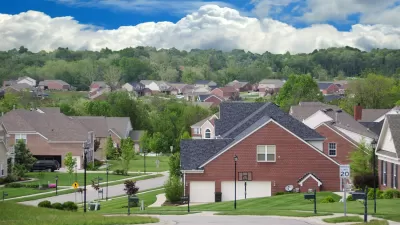It used to be that the nation's rural areas suffered from the highest poverty rates. Today, nearly half of the American poor live in mid-sized counties.

A new study by the Pew Research Center shows that poverty rates have declined over the last 50 years, but the poor are increasingly concentrated in higher-density metropolitan areas rather than low-density rural areas. While rural states such as Maine and North Dakota had higher-than-average poverty rates in 1960, the opposite is true today. By 2010, 21 percent of poor Americans lived in the 20 most populous metro areas of the country. Another 47 percent lived in the mid-sized counties of 100,000 to 1 million people—the urban and suburban counties that surround big cities such as Los Angeles, Chicago, San Francisco, and Dallas-Fort Worth.
As a result, many of the nation’s biggest counties by population had high poverty rates in 2010, though that was not the case in 1960," reports Jens Manuel Krogstad.
The South is still home to the largest share (41 percent) of the nation's poor by a long stretch. However, from 1960 to 2010, the poverty rate was cut in half (from 35.6 percent to 16.4 percent). According to the study, this shift is due in part to an overall 7.2 percentage point reduction in the national poverty rate, but perhaps less obviously, due in part to a population shift of 11 percentage points from rural to urban areas. Poverty used to be entrenched in the rural South and Midwest; today, only 25 percent of the American poor live in counties of less than 100,000 people.
"Twelve of today’s most populous counties had poverty rates above the national average in 2010, including Los Angeles, Cook (Chicago) in Illinois, Maricopa (Phoenix) in Arizona, Kings (Brooklyn) in New York, and Dallas. In 1960, eight of these 12 counties had poverty rates below the national average,” reports Krogstad.
A quick glance at the Pew Center's map of the percent change in poverty shows dramatic increases in the poverty rate across the West, mirroring large population increases in the cities and suburbs of Northern California, Arizona, and Texas. Seven of the ten fastest-growing cities in America are in Texas, Arizona, and California. The fastest-growing city from 2000 to 2010 was Lincoln City, CA, a small town 30 miles north of downtown Sacramento that grew by 282 percent. According to the Census, the poverty rate increased from 9.5 percent in 2009 to 15.9 percent in 2013. Overall, the West's share of poverty has doubled since 1960, from 11 percent to 23 percent.
FULL STORY: How the geography of U.S. poverty has shifted since 1960

Alabama: Trump Terminates Settlements for Black Communities Harmed By Raw Sewage
Trump deemed the landmark civil rights agreement “illegal DEI and environmental justice policy.”

Study: Maui’s Plan to Convert Vacation Rentals to Long-Term Housing Could Cause Nearly $1 Billion Economic Loss
The plan would reduce visitor accommodation by 25% resulting in 1,900 jobs lost.

Planetizen Federal Action Tracker
A weekly monitor of how Trump’s orders and actions are impacting planners and planning in America.

Restoring Northern India’s Himalayan ‘Water Temples’
Thousands of centuries-old buildings protect the region’s natural springs and serve as community wells and gathering places.

Milwaukee to Double Bike Share Stations
Bublr Bikes, one of the nation’s most successful, will add 500 new e-bikes to its system.

DC Extends Application Window for Outdoor Dining Permits
District restaurants will have until the end of November to apply, but businesses with permits in rush hour parking lanes must end operations on July 31.
Urban Design for Planners 1: Software Tools
This six-course series explores essential urban design concepts using open source software and equips planners with the tools they need to participate fully in the urban design process.
Planning for Universal Design
Learn the tools for implementing Universal Design in planning regulations.
Caltrans
Smith Gee Studio
Institute for Housing and Urban Development Studies (IHS)
City of Grandview
Harvard GSD Executive Education
Toledo-Lucas County Plan Commissions
Salt Lake City
NYU Wagner Graduate School of Public Service





























